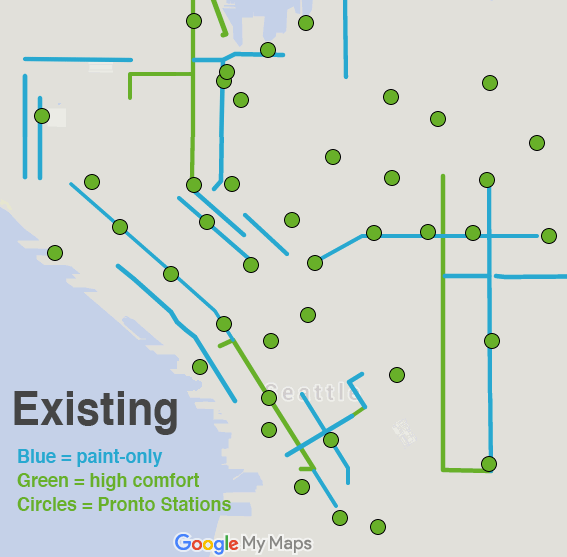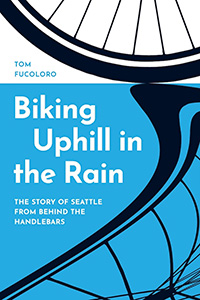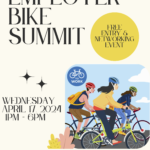Seattle Channel’s excellent City Inside/Out show took on the Pronto Cycle Share situation Friday, including an interview with yours truly and a panel with SDOT Active Transportation Chief Nicole Freedman, Councilmember Mike O’Brien, Rainier Valley Greenways and Rainier Riders leader Phyllis Porter and persistently anti-bike Fremont business leader Suzie Burke.
The episode begins with a good five-minute recap to catch viewers up on how we got here, followed by the discussion. Viewers are then asked to take this one-question poll.
In previous stories, we’ve reported about how Pronto ended up in this do-or-die situation in front of the Council and how the system can flourish in our city.
City Inside/Out quotes me saying, “We have one good bike lane in all of downtown, that’s not a bike-friendly city.” To illustrate that point, I’m reposting a graphic showing how the planned-but-delayed Center City Bike Network will also activate Pronto’s network. But this can only happen if we take action. No more waiting. It’s time.











Comments
23 responses to “Watch: City Inside/Out takes on the Pronto buyout debate”
Is it just me or is this map missing a lot of the current bike lanes? Comparing with google maps, there is a bike lane on 2nd all the way to western (hitting 4 pronto stations). And what about Yesler or 6th ave? I agree that the bike network is badly in need of making more connections, and I know the original graphic had some subtext about including only the most heavily used bike lanes, but this just seems a bit misleading.
You’re right, I’m missing the 2nd Ave painted bike lane. That was a mistake. I’ll edit it. I’m missing Valley St, too, which I’ll add when I get back to my computer.
I left out the Yesler bike lane on purpose because it’s so steep and only goes in one direction: Up (the direction few people actually want to go on that street).
The 6th Ave bike lane has been closed for construction so long I forgot it even existed. I suppose I should add it, too.
The map is subjective in that I only included the bike facilities that are actually useful for getting around within the center city Pronto service area.
Speaking of lanes closed for construction, much of the Western Ave bike lane is closed. And Alaskan way (home to two Pronto stations) is a serious mess due to the sea wall project. You don’t show any bike infrastructure there, but Goggle does show a shared use trail, but with the various construction is in not really usable now.
For Yesler, while many people won’t want to go up the hill, if one has to, then having a bike lane in the up direction is better than one going down where one could keep up with the cars in the general traffic lane (and going 20-30 in a 5ft door zone bike lane is not a great idea) . Also the 2nd ave. painted lane of death is one way as well.
I think that “survey” is pretty poor, 1.4 million wont “save” Pronto, it would postpone its imminent demise, but to really “save” it and to enable “the system to flourish” the decimal point would have to move right a bit.
Yesterday I was riding up 6th Ave and had the same thought about its bike lane, nearly verbatim.
The only quibble I have with this map: I don’t think any actual changes are proposed for Bell west of 5th. It might be cool if they moved southbound buses to Lenora (after finishing construction there) and allowed two-way cycling on Bell, but I’ve never heard any actual official suggest that. So whatever classification it gets now should also be applied to the future, and vice-versa.
Al writes 100 times on the chalkboard, “I will not use this post to complain about the Bell Street pseudo-woonerf,” while every public official with a stake in Belltown writes 100 times, “Bell Street is to be an excellent two-way bike route all the way from Denny to the Sound!”
On the flip side, the survey didn’t point out that the bill for not buying Pronto out is about the same or higher than buying it out ($1.7 million?).
Fort-Worth is crowing about their bike share today. It got something like 40,000 rides with 43 stations last year. That’s a third of our ridership. The thing that’s hurting Seattle’s bike share the most is out-sized expectations.
Regarding the steepness of the Yesler bike lane (which Tom purposely omitted from his map), there’s very expensive separated bike infrastructure currently being installed at the top of the hill, east of I-5 (apparently connected with the Yesler Terrace redevelopment). It seems to me that anyone willing and able to bike up that steep of a street is not the type of cyclist who needs super-protected infrastructure–but nevertheless it is being installed. Is it for novices on e-bikes?
Yesler doesn’t have the right-of-way for a safe downhill bike lane — you’d need at least an 8-foot lane width to be safe at ordinary coasting speed.
Many bikes don’t have brakes that will keep them down to a safe speed in a minimum-width bike lane — remember, the standard width for bike lanes is designed around fast-pedestrian speeds, not 20+ mph down hill.
Add to the list: The 9th Ave bike lane has been closed southbound for a long time, and northbound is now even more closed.
When descending a steep hill like Yesler, it is almost always safer to be in car lane than a traditional bike lane. When doing a high-speed descent, the leading cause of accidents is not cars (especially drivers that are looking right at you from behind) – it’s hazards in the roadway. Besides being wider (providing room to navigate around hazards), car lanes tend to be better maintained than bike lanes and swept clear of debris more frequently, making the overall pavement safer to ride on.
Going up the hill, however, it is completely different. At 5 mph, rather than 20 mph, being separated from the cars is much more important, while potholes or trash in the bike lane is much less important, since at 5 mph, there’s much more time to see it and react to it.
So, yes, including an uphill-only bike lane on a street like Yesler does make sense.
Phyllis, you were fantastic, your remarks were spot on!
I think we should get our facts straight before we continue to blame bike share problems on bad bike infrastructure. Bad bike infrastructure is certainly a problem in many areas of Seattle, but it is separate issue from whether or not bike share can succeed here. How does our infrastructure compare to other cities where bike share has been successful? Is it really that much worse here?
Bringing up the two issues together will only add fuel to the fire of those who don’t want the city to spend money on a transportation option that promotes the health of the environment and citizens, efficient movement of people through the city, an option that will help the city reduce its contribution to climate change.
I know that the map is schematic only but how do you understand the difference between “comfort” and “paint only”?
I was recently going downhill on 2nd ave on the protected bike lane and thought that I would prefer a general traffic lane with sharrows–I dislike to ride on left side of the street, and even more, the bike traffic lights were adjusted in a way that either I had to wait at every junction, or so consistently run the red light. But I may belong to a minority…
I feel the same way you do about 2nd ave downhill. But I think the lane is an excellent addition for those who don’t want to ride in traffic.
But as soon as you go over about 10mph, there’s too much to watch out for. Driveways, cars which might turn left on red. Grates. Peds. And too much waiting for red lights.
Same uphill for me. But again, I want to emphasize that to get more riders into and through downtown, we need to appeal to those who won’t ride in traffic. In other words, those who will ride in traffic already are.
I think we need to recognize that “all ages and abilities” describes an entire street, not just one part of it.
That is, separated lanes for those who feel unsafe in traffic, but also clear affirmation that faster cyclists belong in the street where they’re safer, and where they don’t pose a hazard to slower or more vulnerable sidepath users.
CROW reports that the Dutch Cyclists Union has been supporting this in the Netherlands, getting faster cyclists into the street to make the sidepaths more welcoming for their intended users.
Washington doesn’t have a mandatory sidepath or bike lane law, but for the cost of a little paint, SDOT could make 2nd safer for all cyclists by adding sharrows to the street.
When I was last on second Ave., the proportion of the light cycle devoted to left turns was pretty small, so in the downhill direction, bike lane vs. car lane, the overall time waiting at stoplights doesn’t matter all that much. Usually, I end up having to stop and wait about every 2-3 blocks.
In the uphill direction, it is pretty much stop and wait after every block. Which is not a surprise because the signals are timed for the downhill direction, to match the path of motor vehicles. That said, waiting for a stoplight at every block to ride up the hill is still better than the previous arrangement, where you couldn’t ride up 2nd Ave. at all.
I took Pronto down to the ID for the streetcar party on Saturday. I was surprised to find the 2nd Ave PBL closed in two places despite my checking the SDOT twitter page beforehand as I usually do. People on bikes heading north had to get on the west sidewalk.
SDOT is making it really hard to make their arguments for them.
It seems to me that the price structure is the biggest hurdle. You could argue that a year membership is cheaper than a bike, but that’s only valid if you are taking trips for less than 30 mins. Works if you are on Capitol Hill to downtown but the commute from Fremont/north is more than that. A low income option like that in DC would also be a good idea.
Queue the “it doesn’t take 30 mins” comments but you get the point.
I’ve commented on the price structure before. My thoughts – very briefly this time.
1. Change the $8 all day rate to allow keeping the bike for 4 hours (or at least 2). Opens up the possibility of taking a bike to a meeting, a friends house, lunch. Or for tourists, a ride around lake union, etc.
2. Add a new $2 rate good for one 30 minute ride. This makes the bike share very attractive to someone who just need to get some place once. Or maybe ride downhill from cap hill to downtown.
The price structure is standard for bike share. It’s hard to see how that’s the biggest hurdle when so many successful systems use it.
The way you take bikes to meetings, lunch, etc. is to have docks essentially everywhere in the service zone. I take bike share to dental appointments. 10-minutes to and 10-minutes from. Same for lunch, shopping errands, etc. Car share (and taxi service, for that matter) is priced to penalize leaving the cars just sitting there unused as well, so there’s nothing novel about this.
Some slight changes in the fare structure, such as monthly passes and lower daily charges might be beneficial, but the fare model is fundamentally bike share, not bike rental.
http://www.peopleforbikes.org/blog/entry/bublr-bike-share-will-offer-single-ride-and-monthly-pass-only
More bike infrastructure more driver education more police enforcement. 3 out of 4 people who I know who own bikes and homes in Seattle city limits still restrict their riding out of safety concerns.
[…] today: Bike Walk Lee gives an update on Florida’s horrendous hit-and-run problem. And Seattle Bike Blog considers what it will take for the city’s Pronto bike-share to really […]
Want to see Pronto succeed? Email [email protected] and let them know!
And add your YES to the City Inside/Out poll. The anti-Pronto votes are gaining ground.
http://www.seattlechannel.org/CityInsideOut
It has been brought to my attention (and I thus listened) that Suzie Burke cited me for two specific positions in the referenced InsideOut program. For the record, I want to correct one of the statements she made about my position: She says (at about 9:00) that I oppose City support for Pronto. I believe she misplaced my opposition to another bike project to Pronto. I thought the recent article in Crosscut (http://crosscut.com/2016/02/how-seattle-might-revive-its-bikeshare/) and the debate in the comments laid out the Pronto issues well. However, I have not come to a firm conclusion as to the best path forward for Pronto, and probably won’t; there are more important bike issues around here, like actually creating a bike path system that would allow all us bikers—including the lesser experienced and those who do not have their own helmut handy—to get around town safely.
Unless I misspoke to Suzie, what I did mean to convey is that I am strongly opposed to SDOT’s proposed reconfiguration of 34th to extend the two way bike lane and one way street that currently exists in front of PCC (Fremont Ave to Evanston) west to Phinney. I did support such a configuration in the mid-1990s neighborhood planning process, but have since changed my mind as a result of further consideration of the need and impacts. Some of these are spelled out at
https://groups.google.com/forum/#!topic/fremont-greenways/Ntk8jdAYHho
Suzie also said (c. 15:00) I support a signal at 34th and Troll (under the Aurora Bridge). This is completely accurate.